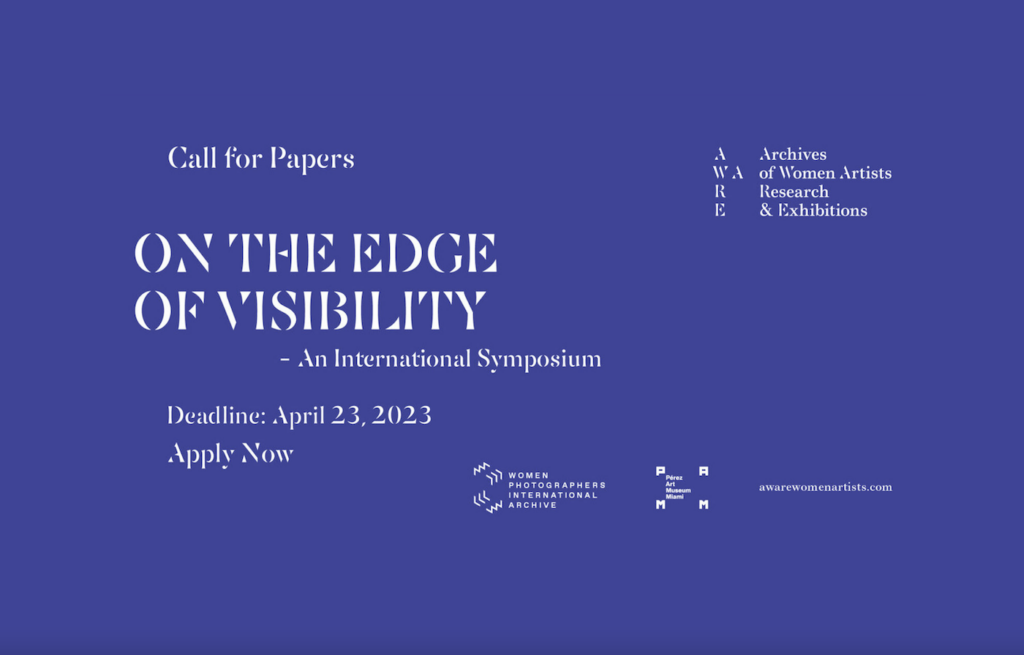Pérez Art Museum, Miami, United States
Deadline: 23 April 2023

Courtesy of AWARE
The Origin of Others. Rewriting Art History in the Americas, 19th Century – Today, organized in partnership with the Clark Art Institute, is a multifaceted three-year research project focusing on Black and Indigenous women artists in three broad geographical zones: Latin America, the Caribbean, and the United States. The program title references the series of essays by the author Toni Morrison, published in 2017.
Looking to bridge the gap created by sexism, racism, and geographical discrimination, the project opens discussion around what it means to achieve institutional visibility and how writing the history of Black and Indigenous women artists in the Americas might challenge existing academic boundaries in art history. Central questions include: What are the complexities of being a Black or Indigenous woman artist across these geographies? What different fundamental societal impediments do these artists face? How can we learn from the past to produce new narratives?
As part of the program, AWARE and Women Photographers International Archive (WOPHA) are launching a call for papers for the On the Edge of Visibility symposium, which will take place at the Pérez Art Museum Miami on 19 and 20 October, 2023.
AWARE: Archives of Women Artists, Research and Exhibitions and Women Photographers International Archive (WOPHA) in partnership with Pérez Art Museum Miami (PAMM) welcome submissions for On the Edge of Visibility.
Offering a transcontinental approach and encompassing postcolonial, feminist, and queer perspectives, this symposium considers the concerns and complexities of defining what it means to be a Black or Indigenous woman artist within different cultural settings. It will also constitute a reflection on past and current modes of knowledge creation.
By exploring the notions of visibility and invisibility as they relate to visual practices and dominant power structures, this symposium aims to examine proposed strategies of resistance as a means of reclaiming visual agency. It will therefore seek to challenge existing academic boundaries – notably within the history of art and photography – through a multiplicity of voices and perspectives, questioning contemporary discourses and their genealogies, and considering the future of the discipline.
Bringing together artists, researchers, curators, and thinkers, this international gathering will be structured around three thematic sections:
The first section, Fractals of Invisibility, will question the historical and structural reasons for the exclusion of Black and Indigenous women and non-binary artists from art historical narratives. It will examine invisibility as an intersectional phenomenon rooted in colonial and contemporary history. The second section, Politics of Visibility, will examine what strategies are effective in gaining institutional recognition and achieving socio-political goals. This section will simultaneously question the creation and replication of stereotyped representations of these artists within the dominant discourse. Finally, the third section, Poetics of Opacity, will focus on the notion of opacity, as theorized by philosopher and poet Edouard Glissant, understood as an impenetrable alterity that cannot be possessed, an epistemological notion that grants everyone the right to keep their psycho-cultural selves. Symposium contributions derived from a critique of visibility and transparency, with considerable input from recent feminist and queer theories, will examine the potential of this concept as an alternative to Western ways of understanding, representing, and recognizing Black and Indigenous women and non-binary artists.
1. Fractals of Invisibility
– What different fundamental societal impediments do Black and Indigenous artists face?
– How has colonial history impacted the institutional recognition of their work?
– How has art history contributed to the invisibilization of some practices while fostering others?
– What are the obstacles and resistances to recognizing these photographers today?
– What role did family, community, multi- and intergenerational archival practices play in the maintenance and transmission of these artists’ work?
2. Politics of Visibility
– What does it mean to achieve institutional visibility?
– What strategies can be implemented to challenge current academic and art historical frameworks?
– What is the role of the collective in fostering institutional recognition?
– How can photography help to achieve social and political goals?
3. Poetics of opacity
– What are the complexities of being visible as a Black or Indigenous woman or non-binary artist across these geographies?
– What risks arise from over-exposure and hypervisibility?
– How does (in)visibility relate to power?
– What tactics of opacity exist? How can it be a source of visual agency and sovereignty?
*Woman is used in this context for a person, who regardless of their gender assigned at birth, identifies as a woman.
**Photographic practices include but are not limited to creating images with or without cameras, automated and computational processes, augmented photography, and collecting, archiving, or circulating images.
Interested participants are invited to submit an abstract of no more than 400 words, along with a CV, to appelaprojets@aware-art.org by April 23rd, 2023. Accepted participants will be notified in May 2023.